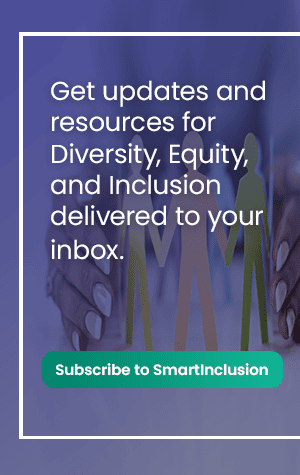SmartSearch’s DE&I Champion, Sylvia Dahlby talks with Roger Simmons, president and Chief Operating Officer of Crossinculture, a consulting firm with extensive experience in providing cultural competency training for organizations that want to improve cross-cultural awareness. This is part of a series of video conversations with thought leaders on practical solutions to help create and promote excellence in Diversity, Equity & Inclusion.
Watch the conversation here or read more for the synopsis.
The biggest misconception is thinking that just by having diverse people together, you’re representing diversity. If you have a variety of people who are different, you could think that, yes, this is a good representation of diversity.
I’ll give you an example: I was approached by a Board Member of a not-for-profit organization. He said, hey, Roger, our board lacks color, and we need some diversity, and I’d love for you to be a part of the Board. I felt really offended because he seemed to think that just having different people together with different colors or looks, different from each other, that alone would make this board a great representation of diversity.
He did not consider my intelligence or competency. He did not present to me why I would want to be a part of the Board or how I would contribute because I have these skills, or these competencies, or this experience, and this is how I could add value to the organization’s overall vision or mission and things like that. He wanted me to be on the board as a token. He just wanted my face in the picture.
So I walked away. I never responded to him because I felt like I might have been disrespectful if I did. But I began to think about that. Some of us believe that if we have different people together, we are representing diversity. And that’s a misconception.
It starts by ensuring that different voices are amplified. You need a system or structure where everyone is heard regardless of background, ethnicity, or what have you.
heard regardless of background, ethnicity, or what have you.
Start with a focus group to get a baseline; a good way to detect deficiencies or areas that need improvement is by having focus groups—asking questions, doing assessments, and listening to small groups of people. This is how you can identify indicators. When you do focus groups, you get people talking in small groups, and the dialogue opens up the flow of ideas.
It’s important when people can say what they think is necessary because they think “I’m necessary.”
Give people the opportunity to explain what they can bring to an organization and what values they add to the whole and the vision. If people can answer that and share how they feel in that workspace and why they are necessary, they will help set the goals and initiatives and help the company move forward. That’s how you get good indicators that diversity is working.
In any business, you have opportunities, and also you have challenges. You need both. The opportunity or challenge that embraces differences in approach will breed creativity and innovation.
Diversity that works empowers people because they feel that they can contribute. There’s a sense of ownership at a high level of engagement.
People feel empowered when they have the freedom to show up to work as their whole selves; that’s when the creativity kicks in. It’s okay to have those turbulent kinds of relationships. When people with different perspectives rub together, there will be conflicts. Yet when we can listen to each other enough, we can understand how things should be right or in accord.
Create a space where there can be honest dialogue, a space where people can’t Google anything. Instead, engage one another and look each other in the eye. I can Google on my phone and come up with thousands of good ideas. But the better ideas are the things that we can’t Google. The things we can’t find on the internet are the things we get in dialogue with each other.
So creating space where you can put the phone down and engage each other’s thinking and perspective. Talk to actual people when we’re questioning each other; that’s where there’s critical thinking, where we’re challenging each other, where we have to be able to try things, take risks, and grow.
Roger Simmons is the President and COO of Cross in Culture, a consulting firm with extensive experience in providing cultural competency training for organizations that want to improve cross-cultural awareness. Roger is also an adjunct professor at Judson University, where he instructs students on cultural diversity topics. He provides training in cultural awareness for religious and community groups and builds coalitions and collaborations across educational and nonprofit organizations to develop programs, policies, and practices that promote an institutional culture of diversity, equity, and inclusive excellence.
As we develop our HR technology platform to support diversity in recruiting and employment equity, we’re talking with our clients, vendor partners, industry advocates, and thought leaders on trends, challenges, and solutions to create a more inclusive workplace.